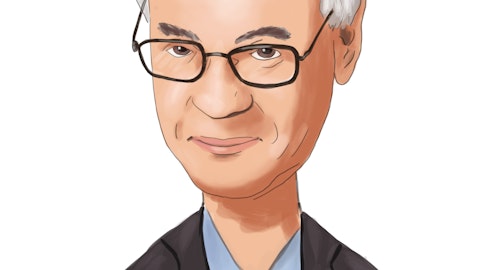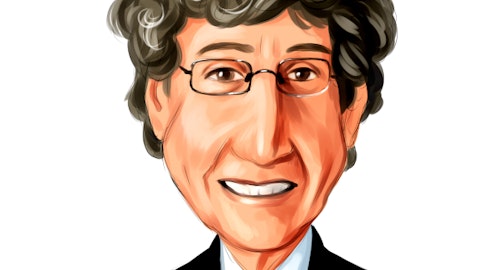Chris McGratty: And Steve, maybe for you on capital. You talked about the flexibility and the actions you’ve taken. Do you expect opportunities to arise in 2024 at the industry level, given some of the stress on rates and maybe how you would maybe update us on your ranks of capital year for 2024?
Steve Gardner: I would say we do expect opportunities to rise, but I thought that in 2023 as well. And so we’ll just see how the year plays out here. I think as I mentioned, given all the uncertainties in the environment, whether it’s around the commercial real estate markets or a variety of other areas and just how the economy develops and given all of the geopolitical risks, intentions out there, I think our approach is going to continue to be that we’re going to retain capital where we see opportunities to put it to work where it benefits the organization long term, we’re going to do that. But overall, it remains — there’s a level of uncertainty and we are very comfortable having strong levels of capital.
Operator: The next question is from Gary Tenner with D.A. Davidson.
Gary Tenner: I wanted to ask about the fourth quarter noninterest bearing outflow. Can you parse maybe how much of that you would chalk up to tax payment seasonality versus kind of the ongoing shift in mix, and a sense of timing of how rapidly the seasonality piece of it could come back on balance sheet?
Steve Gardner: It’s hard to put a specific measurement on it, Gary, as far as the — from the tax payments and all of the movements that are going on. As Rob mentioned, we’re seeing clients continue to pay down or pay off loans and so that impacts both sides of the balance sheet naturally. Certainly, in 2023, in the state of California, we saw later tax payments come out, some of the impacts on commerce escrow. Our sense is though that, that magnitude, we don’t expect to see that as we move through the year and typically, some of those funds begin to return in the first half of the year. How much will come back is uncertain. Again, I think, it in part, it has to deal with the yield curve, how businesses are feeling about the overall environment. So we’ll see how things play out here. I think one of the benefits we have is just the number of new accounts that we’ve opened in 2023. And as those get fully implemented and onboarded we may pick up some benefit there.
Gary Tenner: And bigger picture, I guess, on the funding side, pre-pandemic you all have often operated the company at or at times slightly above 100% loan deposit ratio, even with the wholesale reductions in the fourth quarter and the net deposit moves there, you’re back up by only 89%. So as you’re thinking about the longer term management of the balance sheet, how are your thoughts on that today relative to where they were a few years ago?
Steve Gardner: I think that when you think about it pre-pandemic, we were also quite a bit smaller in total assets. I don’t see us running the business. We don’t think it would be prudent at 100% loan-to-deposit ratio but we could certainly see in the low to mid-90% range. Certainly, we’d like to get there by growing both sides of the balance sheet, both the loans and deposit side to increase that over time prudently.
Gary Tenner: And one last question for me, if I could. Ron, in terms of the hedges, I know you added some in the third quarter, it doesn’t look like you added any here in the fourth quarter. But can you just remind us kind of what the maturity schedule is of those swaps?
Ron Nicolas: We’ve got about $1.3 billion in totality in the swap book and approximately half of those hedges will mature by the end of this year. And then we’ve got another tranche, if you will, another 25% early in 2025. And then the rest are just laddered out just a little bit longer.
Operator: [Operator Instructions]. The next question is from Andrew Terrell with Stephens.
Andrew Terrell: First question, Ron, can you just remind us the $600 million of termed FHLB advances you’ve got in outstanding right now, what’s the maturity schedule look like for those?
Ron Nicolas: Well, we’ve got a third of that tranche maturing this quarter. So we’ll see that come off. And then I think we’ve got another tranche late in the year and then next year.
Andrew Terrell: And then can you just talk to us overall about the — I guess, I’m trying to figure out what kind of the right cash position is on the balance sheet. And then how you pair that against — I would assume that you’d use cash to pay down some of the termed FHLB that matures this quarter potentially some more brokered. Can you just talk to us kind of about the cash balance where you’d like to see it set and then what the uses of that cash would be?
Ron Nicolas: So obviously, coming out of the post pandemic and given the rapid rate rise us and many in the industry want much more heavily into the cash I’d say under our normal operating levels, we’re probably in the $400 million, $500 million range. We’re more than double that today. And so I could see us over time depending upon deposit flows, loan growth, as we’ve talked a little bit about, we could see that coming back down to those normal levels as we move throughout the remainder of 2024, of course, notwithstanding any other challenges that come about from a macro standpoint.
Andrew Terrell: And then on the securities portfolio, do you have just what the spot yield was on the securities book at 12/31?
Ron Nicolas: Yes, 3.48%.
Andrew Terrell: And then one more question on the margin. I think in the third quarter, there was an interest accrual that was a headwind in the third quarter. So all else equal, that was I think, if I recall, 4 or 6 basis points positive to 4Q loan yields, just the falling off of that. So I guess the question is about kind of loan yields going into 2024 and just on a quarterly or annual basis, just as loans are coming up for renewal. What type of what loan yield improvement you would expect kind of throughout the year just as adjustable rate loans reprice or the lower yielding fixed rate loans come off?
Steve Gardner: There’s a lot of moving pieces there, Andrew, to come up and we don’t have an estimate out there that we’ve stated publicly. But obviously, a lot of moving parts about how much of the maturing loans we end up retaining what the — how borrowers, what their decisions are around loans that are adjusting, frankly, some of the higher yielding stuff is paying off faster than some of the lower yielding loans, certainly, what is the rate and volume of of new production. Certainly, we like the yield of new loans that we’re putting on today, they’re pretty attractive from a risk-adjusted basis. But as I mentioned, demand is pretty muted. Ron, do you have anything to add there, in particular?



